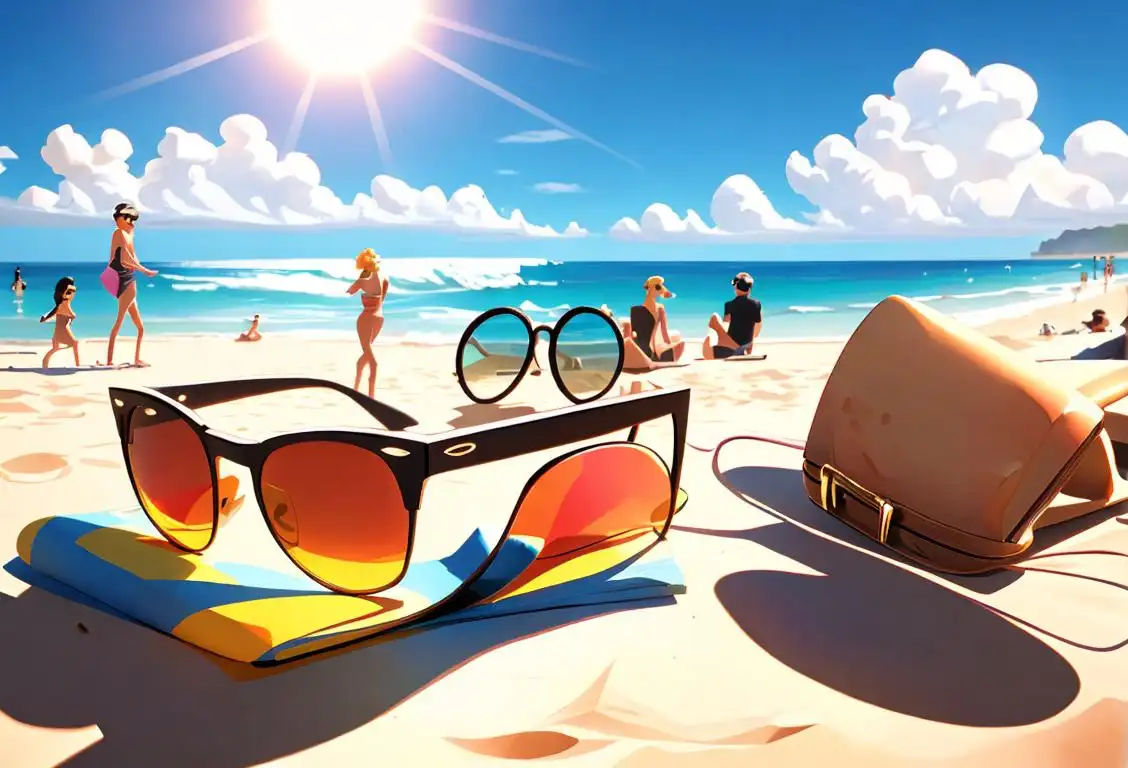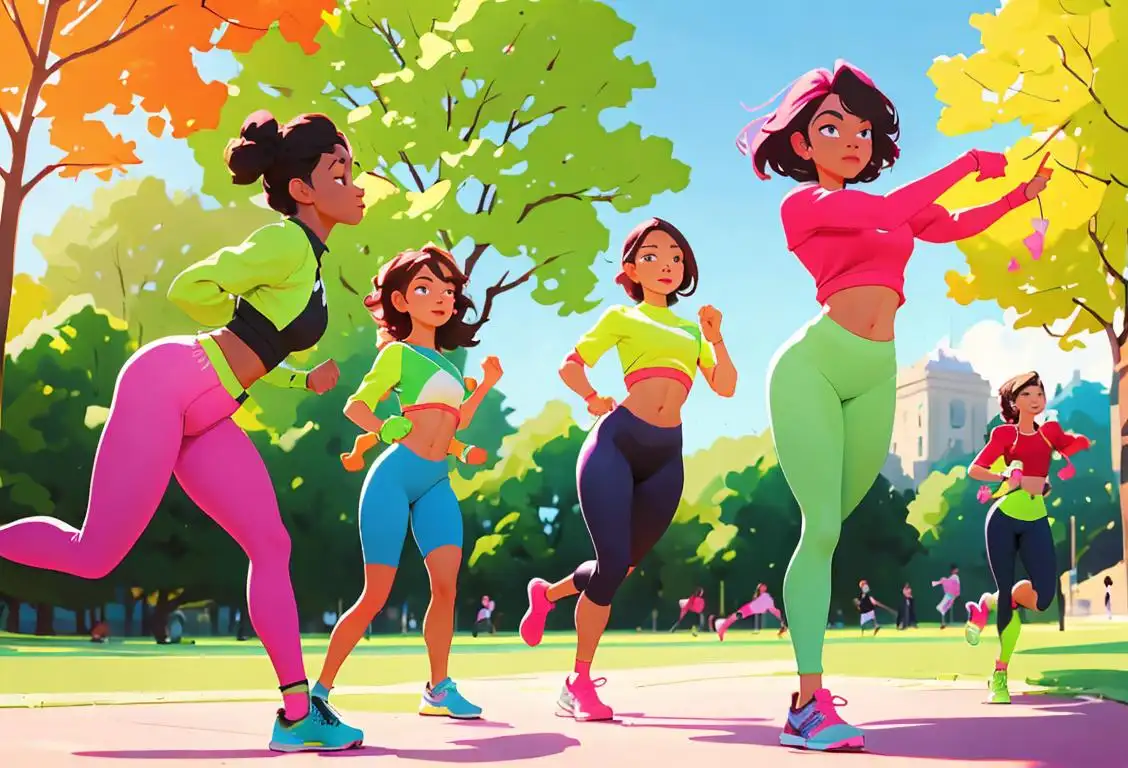National Sun Glass Day

Welcome to National Sunglass Day, the day where we celebrate those glorious shades that protect our eyes from harmful sun rays. Whether you're a trendsetter or simply a fan of looking mysteriously cool, this is the day for you. So grab your favorite pair of sunglasses and get ready to shine brighter than the sun!
When is Sun Glass Day?
It's national sun glass day on the 27th June.
History of National Sunglass Day
The internet has embraced National Sunglass Day with open arms. This special day first gained popularity on June 27, 2016, when it received a whopping 16 online mentions. Who knew that sunglasses could generate so much buzz? The origins of National Sunglass Day remain a bit of a mystery, but it's safe to say that people have been celebrating the awesomeness of sunglasses for many years.
Why Should You Celebrate?
Let's be honest, sunglasses are not only a fashion statement, but they also serve an important purpose. From shielding our eyes from harmful UV rays to adding an extra touch of coolness to any outfit, sunglasses are a true essential. But National Sunglass Day goes beyond just looking fabulous; it's a reminder to take care of our eyes and embrace the sunny side of life.
How to Celebrate National Sunglass Day
Celebrating National Sunglass Day is as easy as slipping on a pair of shades. Here are a few ideas to make your day even more special:
- Show off your favorite sunglasses on social media using the hashtag #NationalSunglassDay. Don't forget to strike a pose and let the world know you're ready for the spotlight!
- Organize a sunglasses-themed gathering with friends and family. From a beach picnic to a rooftop party, the options are endless. Don't forget to wear your most stylish sunglasses!
- Take some time to educate yourself about eye health. National Sunglass Day is the perfect opportunity to learn about the importance of protecting your eyes and maintaining good vision.
Did You Know?
Inspired by the movie industry, sunglasses became popular in the 1930s as a way to shield the eyes of actors and actresses from the bright lights on set. Little did they know that sunglasses would become a worldwide fashion trend loved by millions!
History behind the term 'Sun Glass'
1752
Invention of Smoked Glasses
In the year 1752, James Ayscough, an English optician, invented smoked glasses. These glasses were made from smoked quartz lenses and were primarily used to correct vision impairments caused by specific eye conditions, such as cataracts and glaucoma. The lenses had a dark tint, which provided relief from bright light and reduced glare. Though they were not yet known as 'sun glasses,' this invention marked an early development in the quest for eye protection from the sun.
1914
The Birth of Sun Glasses
The term 'sun glass' originated in 1914 when Foster Grant, an American entrepreneur, introduced sunglasses as a wearable accessory. Foster Grant marketed his sunglasses as 'sun glasses' due to their purpose of shielding the eyes from the sun's rays. The term quickly became popular and has stayed in use ever since.
1752
The Birth of Sunglasses
In 1752, James Ayscough, an English optician, started experimenting with tinted lenses. He believed that blue or green-tinted glasses could help correct specific vision impairments. Although his intentions were to improve vision, this marked the beginning of what we now know as sunglasses.
1929
Creation of Modern Sun Glasses
In 1929, Sam Foster, an American entrepreneur, started mass-producing modern sunglasses. Foster's sunglasses were made with a more durable, lightweight material known as celluloid. These sunglasses began to gain popularity, not only for their protection against the sun's harsh rays but also as a fashionable accessory. Foster's brand, Foster Grant, became one of the leading manufacturers of sunglasses, and their popularity continued to rise throughout the 1930s.
1929
The Rise of Sun Glasses
Sunglasses gained popularity in the late 1920s when Sam Foster, an American entrepreneur, mass-produced them. Foster initially began selling sunglasses on the beaches of Atlantic City, New Jersey. His company, Foster Grant, became one of the first to market sunglasses to the general public. The stylish and protective nature of sunglasses caught on, making them a fashionable accessory.
1936
Polarized Lenses Revolutionize Sun Glasses
In 1936, a scientist named Edwin H. Land invented polarized lenses, which greatly improved the functionality of sun glasses. Polarized lenses reduce glare caused by light reflected off flat surfaces, such as water or roads. This innovation provided a more comfortable visual experience and enhanced eye protection, making sun glasses even more popular among outdoor enthusiasts and drivers.
1936
Introduction of Polarized Lenses
In the year 1936, Edwin H. Land, an American scientist and inventor, introduced polarized lenses. While working on a material to eliminate glare for camera lenses, Land developed sunglasses with polarized lenses. These lenses had a special filter that allowed only vertically oriented light to pass through, effectively reducing horizontal glare. This innovation revolutionized the sunglasses industry, making polarized sunglasses a key choice for activities like fishing, skiing, and driving.
1936
Ray-Ban's Aviator Revolution
In 1936, Ray-Ban released the iconic Aviator sunglasses. Originally designed for American pilots, the Aviator quickly gained popularity among civilians as well. With the Aviator's teardrop-shaped lens and sleek metal frame, they became a symbol of coolness and style. Ray-Ban's Aviator set the trend for future sunglasses designs.
1960
Fashionistas Embrace Sun Glasses
During the 1960s, sun glasses became a symbol of fashion and personal style. Celebrities and fashion icons such as Audrey Hepburn and Marilyn Monroe frequently wore sun glasses, sparking a trend that resonated with the general public. Sun glasses evolved from a functional accessory to a fashion statement, adding an element of coolness and mystique to anyone wearing them.
1960s
Pop Culture and Celebrities
During the 1960s, sunglasses started appearing on celebrities and in popular culture. Icons like Audrey Hepburn in "Breakfast at Tiffany's" and Steve McQueen in "The Thomas Crown Affair" made sunglasses a must-have accessory. The association with fame and glamour further elevated sunglasses' status in the fashion world.
1965
Popularity Surge with Celebrities
In 1965, an iconic moment occurred for sunglasses when the movie 'Breakfast at Tiffany's' was released. Audrey Hepburn, who played the lead role, sported a pair of oversized sunglasses designed by Oliver Goldsmith. This fashion statement sparked a craze for similar sunglasses, and people began associating sunglasses with sophistication and style. The trend continued to expand as other celebrities followed suit, using sunglasses not only as a means to protect their eyes but also as a fashion statement.
1980
Sport Performance Sun Glasses Rise in Popularity
In the 1980s, the term 'sun glasses' expanded to encompass specialized eyewear designed for various sports activities. Brands like Oakley and Ray-Ban developed sun glasses with lightweight frames, impact-resistant lenses, and advanced optics to enhance performance and protect athletes' eyes. This led to a surge in the popularity of sport-focused sun glasses, becoming an essential accessory for athletes and outdoor enthusiasts alike.
2000
Rise of High-End Designer Sun Glasses
In the 2000s, the market for sun glasses diversified, and high-end designer brands began offering luxurious and prestigious options. Designers such as Gucci, Prada, and Chanel incorporated sun glasses into their fashion lines, turning them into status symbols. Luxury sun glasses often feature intricate designs, premium materials, and exclusive collaborations, attracting fashion-conscious customers who seek both style and quality.
1980s
Sports and Endorsements
During the 1980s, sunglasses became closely associated with various sports and endorsements. Athletes started wearing sunglasses during their games to shield their eyes from the sun, improving their performance by reducing glare and enhancing their vision. This practice soon became a norm, further promoting the use of sunglasses. Furthermore, many brands forged partnerships with athletes and celebrities to promote their sunglasses, solidifying their position as a fashion accessory.
1980s
Sports and Performance Sunglasses
In the 1980s, sunglasses evolved to cater to specific sports and outdoor activities. Brands like Oakley introduced innovative designs with lightweight frames and specialized lenses, designed to enhance performance. Sunglasses became not only a fashion statement but also a functional tool for athletes and outdoor enthusiasts.
Present
Versatile and Fashionable Accessory
In the present day, sunglasses have become an essential fashion accessory for people worldwide. They are available in various styles, colors, and shapes, catering to diverse tastes and trends. Apart from protecting our eyes from harmful UV rays, sunglasses have become a symbol of individuality and style, worn by people of all ages and backgrounds.
Did you know?
Did you know that sunglasses were originally invented to protect the eyes of actors and actresses from bright lights on set?Tagged
fun health fashionFirst identified
27th June 2016Most mentioned on
27th June 2016Total mentions
16Other days
Sun Glass Day
Wear Red Day
Ugly Christmas Sweater Day
Dress Like Your Inner Hoe Day
No Bra Day
Women Physicians Day
Hat Day
Fitness Day
Drug Test Day
School Nurse Day







